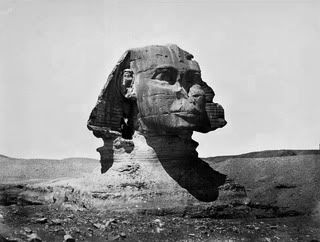The Great Sphinx
 The Great Sphinx was excavated from a relatively soft, natural limestone, left over in the quarry used to build the Pyramids; the forepaws being separately made from blocks of limestone.
The Great Sphinx was excavated from a relatively soft, natural limestone, left over in the quarry used to build the Pyramids; the forepaws being separately made from blocks of limestone.
One of the main oddities about the sculpture is that the head is out of proportion to its body. It could be that the head was re-carved several times by subsequent pharaohs since the first visage was created, though on stylistic grounds this is unlikely to have been done after the Old Kingdom period in Egypt (ending around 2181 BC). Perhaps the original head was that of a ram or hawk and was recut into a human shape later. Various repairs to the damaged head over thousands of years might have reduced or altered the facial proportions. Any of these explanations could account for the small size of the head in relation to the body, particularly if the Great Sphinx is older than traditionally believed.
The Dating of the Great Sphinx
There has been lively debate in recent years over the dating of the monument. Author John Anthony West first noticed weathering patterns on the Sphinx that were consistent with water erosion rather than wind and sand erosion. These patterns seemed peculiar to the Sphinx and were not found on other structures on the plateau. West called in Geologist and Boston University professor Robert Schoch, who, after examining the new findings, agreed that there was evidence for water erosion.
Although Egypt is arid today, around 10,000 years ago the land was wet and rainy. Consequently West and Schoch concluded that in order to have the effects of water erosion they found, the Sphinx would have to be between 7,000 and 10,000 years old. Egyptologist’s dismissed Schoch’s theory as highly flawed; pointing out that the once prevalent great rain storms over Egypt had stopped long before the Sphinx was built. More seriously, why were there no other signs of water erosion found on the Giza plateau to validate West and Schoch’s theory? The rain could not have been restricted to this single monument. West and Schoch have also been criticised for ignoring the high level of local atmospheric industrial pollution over the last century, which have severely damaged the Giza monuments.
Someone else with his own theory behind the Sphinx’s date is author Robert Bauval. Bauval published a paper in 1989 showing that the three Great Pyramids at Giza, and their relative position to the Nile, formed a kind of 3-D ‘hologram’ on the ground, of the three stars of Orion’s belt and their relative position to the Milky Way.
Along with Fingerprints of the Gods author Graham Hancock, Bauval developed an elaborate theory that the Sphinx, its neighbouring pyramids and various ancient writings, constitute some sort of astronomical map connected with the constellation Orion. Their conclusion is that the best fit for this hypothetical map is the position of the stars in 10,500 BC, so pushing the origin of the Sphinx even further back in time. This date is understandably disputed by Egyptologists, as not a single archaeological artefact dated to that period has ever been discovered in the area.
Secret Passageways?
There are various legends of secret passages associated with the Great Sphinx. Investigations by Florida State University, Waseda University in Japan, and Boston University, have located various anomalies in the area around the monument, although these could be natural features. In 1995, workers renovating a nearby parking lot uncovered a series of tunnels and pathways, two of which plunge further underground close to the Sphinx. Robert Bauval believes these are contemporaneous with the Sphinx itself. Between 1991 and 1993, while examining evidence for erosion at the monument using a seismograph, Anthony West’s team found evidence of anomalies in the form of hollow, regularly shaped spaces or chambers, a few metres below the ground, between the paws and at either side of the Sphinx. No further examination has been allowed.
Today, the great statue is crumbling because of wind, humidity and the smog from Cairo. A huge and costly restoration and preservation project has been underway since 1950, but in the early days of this project cement was used for repairs which was incompatible with the limestone, and so caused additional damage to the structure. Over a period of 6 years over 2,000 limestone blocks were added to the structure and chemicals were injected into it, but the treatment failed. By 1988 the sphinx’s left shoulder was in such a state of deterioration that blocks were falling off. At present restoration is still an ongoing project under the control of the Supreme Council of Antiquities, who are making repairs to the damaged shoulder and attempting to drain away some of the subsoil. Consequently, today the focus is on preservation rather than further explorations or excavations, so we will have to wait a long time yet before the Great Sphinx gives up her secrets.
Further Reading
Bauval, R. & Hancock, G. Keeper of Genesis: A Quest for the Hidden Legacy of Mankind. Arrow. 2001.
Fagan, B. M. (ed). The Seventy Great Mysteries of the Ancient World. Thames & Hudson. 2001.
James, P. & Thorpe, N. Ancient Mysteries. Ballantine Books. 1999.
Jordan, P. & Ross, J. Riddles of the Sphinx. New York University Press. 1998.
http://guardians.net/egypt/sphinx – ‘Guardian’s Sphinx – Guardian of the Horizon’.
http://www.touregypt.net/featurestories/sphinx1.htm – ‘The Great Sphinx of Giza – An Introduction’ by Allen Winston.
http://news.discovery.com/archaeology/great-sphinxs-walls-rise-again.html – ‘Great Sphinx’s Walls Rise Again’.
Read more about the Great Sphinx
in my book Hidden History
Pages: 1 2





